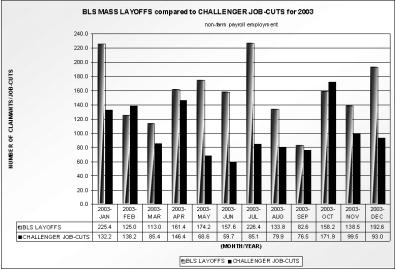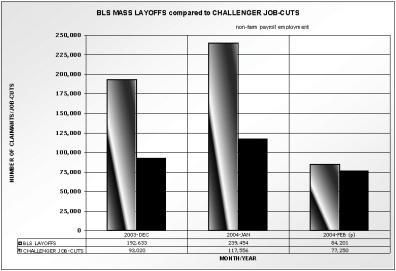Patricia Johnson: Challenging Challenger
Challenging Challenger *
BY Patricia Johnson
Following her testimony before the 911 Commission, Howard Fineman, [Newsweek], refers to Condoleezza Rica as ''a self-proclaimed expert at understanding 'structural' change in large institutions'', then goes on to explain her failure to recognize changes in her own job (click here).
How does a person become a “self-proclaimed expert”? Do you just wake up one morning and decide you’re an expert in a given field and remain an expert until your expertise is challenged?
Each month various economic indicators are released and these figures have a major impact on this country, yet, in some cases very little information is published about the source of the data that is being released.
A prime example is the Challenger Report of announced corporate layoffs. The Challenger Report is released monthly by the Chicago based outplacement firm of Challenger, Gray and Christmas, Inc. This report is used as a general economic indicator for reporting trends in the labor market, and the report released on April 6, includes the following data, not seasonally adjusted, for the month of March 2004 (click here).
- Announced job cuts 68,034 – down from the 77,250 job cuts announced for the month of February 2004. - Planned layoffs in the first quarter of 2004 dropped 101,506 from 364,346 in the last quarter of 2003, to 262,840 in the first quarter of 2004. - The 12-month moving average fell from 96,736 to 95,289. February was the first time the moving average fell below 100,000. This figure is calculated by adding the most recent job cut announcements to the past eleven months and dividing by 12.
This report came on the heels of the Department of Labor, Bureau of Labor Statistics report indicating U.S. non-farm employment grew by 308,000 jobs during the month of March 2004 and the media went wild with headlines reading “Job Cuts Hit 9-month low in March”, “Tech Job Cuts at Record Lows”, “Overall March Job Cuts Lowest in Nine Months”, etc., etc.
The upbeat economic news was definitely a factor in the DJIA closing higher April 6, the day the report was released.
04-05-2004 10,558.37
04-06-2004 10,570.81
04-07-2004 10,480.15
04-08-2004 10,442.03
An improved labor market, while good for the stock market, is not good for the bond market, and “The surprise increase in payroll cased bonds to post the worse sell-off since July last year” according to Chad Hudson’s Mid Week Analysis. (click here).
Since economic indicators have market impact which may result in financial gains and/or losses, it’s imperative that the information released is both accurate and correctly reported.
Paul Lim, US News and World Reports, made the following statement in his article “Behind the job numbers” (click here) “The Challenger survey confirms that the job market is finally turning. “ The heavy job cutting we have seen over the past three years appears to be trending down," says Challenger Gray chief executive John Challenger.”
The entire sentence should read as follows: " The heavy job cutting we have seen over the past three years appears to be trending down. However, the job market seems to be in a state of limbo, where companies are eager to hold on to the people they have but many are reluctant to create any new jobs," (click here).
Do a few missing words make a difference?
John Challenger, CEO of Challenger, Gray & Christmas, Inc. is considered an expert in the field of corporate layoff announcements. It appears Challenger has provided data on layoff announcements for at least a 10-year period of time. Is Challenger an expert in the field, or is he just a self-proclaimed expert? I don’t know the answer to that question. What I do know is there is very little backup data that I’m able to locate, to support the numbers provided by Challenger, Gray and Christmas.
When the report was issued I sent an inquiry to Challenger, which was forwarded to their PR firm, Herbert H. Rozoff Public Relations, Inc. A subsequent e-mail to Herbert Rozoff with basic questions regarding the data used for preparing this report remains unanswered.
While I don’t know the basis for the report, I do believe there should be some correlation between the Challenger report of announced job-cuts and subsequent unemployment claims, as layoff announcements should be a leading indicator of new unemployment claims. Granted, there will be discrepancies, as a company may announce job-cuts and then not follow up with the actual layoffs, or may layoff an increased number of individuals.
A cursory review of the chart immediately indicates that the figures from the Challenger report have little relation to the information from the Department of Labor, Bureau of Labor Statistics.
Although we don’t know much about the source data for the Challenger report, we do know the basis for the Mass Layoff report compiled by the DOL Bureau of Labor Statistics. The Mass Layoff Statistics (MLS) program is a joint, federal-state program that tracks the number of layoffs based on initial unemployment claims filed with a state, for establishments with at least 50 initial claims. Establishments with fewer than 50 initial claimants aren’t included.
A chart showing only the activity for the past three months [Bureau of Labor Statistic data is not yet available for March] provides us with a clearer picture. The reported job-cuts by Challenger were less than ½ the number of new filings for unemployment insurance benefits reported by the BLS. If the discrepancy between the two reports is simply a matter of timing, then the total shown for job-cuts for the month of February should be considerably higher, yet it’s not.
While the economic world in general is grinning from ear to ear over all the good news, I have to ask myself why? An economic recovery without jobs is not a recovery and that’s the bottom line. Supposedly there were 308,000 jobs created in the month of March, but were there?
The Summary of Strike Activity During Survey Reference Pay Period [Includes strikes of 1,000 workers or more] indicates that 72,000 employees were on strike in February and returned to work during the month of March as follows (click here).
| Industry | NAICS | Company Name | Strike Period | No. of Workers |
| Wholesale and retail trade | 445110 |
| 10-12-2003 to 02-29-2004 | 70,000 |
| Transportation and utilities | 493110 |
| 11-25-2003 to 02-29-2004 | 2,000 |
There are
several problems with these figures as
follows:
1. By definition, a person is “employed” if they have a job, but not at work during the reference period for various reasons, including labor-management disputes. So even though the striking workers were not at work, they were counted as “employed” for the duration of the strike.2. The replacement workers hired by the various companies during the strike are also listed as “employed”, as no adjustments are made for replacement personnel.
It’s quite possible that these 72,000 jobs were counted twice during the month of March.
A little over a year ago this country waged a war against Iraq based on inaccurate information. Over and over we heard that Iraq had weapons of mass destruction and immediate action had to be taken, or we would be their next target. Ongoing polls indicated the majority of Americans felt Saddam Hussein was responsible for the events that happened on 9/11. Obviously Iraq was responsible for 9/11 – why else would we attack?
The one lesson that should have been learned from our experience is Iraq is we cannot accept every piece of information provided to us, as being gospel. We have a responsibility, to each other, to question and verify the data supplied to us, and if necessary challenge the numbers.
* Title courtesy of Richard Walrath
© 2004 Patricia Johnson
Patricia Johnson is a freelance writer residing in the Midwest




 Peter Dunne: Dunne's Weekly - Trump's Tariffs Still Pose Risks For New Zealand
Peter Dunne: Dunne's Weekly - Trump's Tariffs Still Pose Risks For New Zealand Keith Rankin: Barbecued Hamburgers And Churchill's Bestie
Keith Rankin: Barbecued Hamburgers And Churchill's Bestie Gordon Campbell: On Why The US Stands To Lose The Tariff Wars
Gordon Campbell: On Why The US Stands To Lose The Tariff Wars Eugene Doyle: Before It’s Too Late - Reimagine New Zealand’s Military Future
Eugene Doyle: Before It’s Too Late - Reimagine New Zealand’s Military Future  Binoy Kampmark: Gender Stunts In Space - Blue Origin’s Female Celebrity Envoys
Binoy Kampmark: Gender Stunts In Space - Blue Origin’s Female Celebrity Envoys Richard S. Ehrlich: A Deadly Earthquake & Chinese Construction
Richard S. Ehrlich: A Deadly Earthquake & Chinese Construction